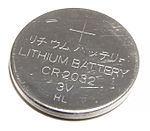Nonvolatile BIOS memory refers to a small memory on PC motherboards that is used to store BIOS settings. It is traditionally called CMOS RAM because it uses a volatile, low-power complementary metal-oxide-semiconductor (CMOS)SRAM (such as the Motorola MC146818 or similar) powered by a small "CMOS" battery when system and standby power is off.[1] The typical NVRAM capacity is 256 bytes.[2]
The CMOS RAM and the real-time clock have been integrated as a part of thesouthbridge chipset and it may not be a standalone chip on modern motherboards.[2]
CMOS battery
The memory battery (aka motherboard, CMOS, real-time clock (RTC), clock battery)[3][4] is generally a CR2032 lithium coin cell. These cells last two to ten years, depending on the type of motherboard, ambient temperature and the length of time that the system is without power, while other common cell types can last significantly longer or shorter periods, such as the smaller CR2016which will generally last about 40% less than CR2032. Higher temperatures and longer power-off time will shorten cell life. When replacing the cell, the system time and CMOS BIOS settings may revert to default values. This may be avoided by replacing the cell with the power supply master switch on. On ATXmotherboards, this will supply 5V standby power to the motherboard even if it is apparently "switched off" and keep the CMOS memory energized.
Some computer designs have used non-button cell batteries, such as the cylindrical "1/2 AA" used in the Power Mac G4 as well as some older IBM PC compatibles, or a 3-cell NiCd CMOS battery that looks like a "barrel" (common inAmigas and older IBM PC compatibles), which serves the same purpose.
source wikipedia
CMOS BATTERY DEFINITION BY COMPUTERHOPE.COM
1. Alternatively referred to as a Real-Time Clock (RTC), Non-Volatile RAM (NVRAM) or CMOS RAM, CMOS is short for Complementary Metal-Oxide Semiconductor. CMOS is an on-board, battery powered semiconductor chip inside computers that stores information. This information ranges from the system time and date to system hardware settings for your computer. The picture shows an example of the most common CMOS coin cell battery used to power the CMOS memory.
The Motorola 146818 chip was the first RTC and CMOS RAM chip to be used in early IBM computers; capable of storing a total of 64 bytes of data. Since the system clock used 14 bytes of RAM, this left an additional 50 bytes for storing system settings. Today, most computers have moved the settings from CMOS and integrated them into the southbridge or Super I/O chips.
How long does the CMOS battery last?
The standard lifetime of a CMOS battery is around 10 Years. However, this can vary depending on the use and environment in which the computer resides. If the battery fails, the system settings, date, and time will not be saved when the computer is turned off until it has been replaced.
Which devices use CMOS?
- Digital logic circuits
- Static RAM (SRAM)
- Microprocessors
- Microcontrollers
copied from computerhope.com


Comments
Post a Comment